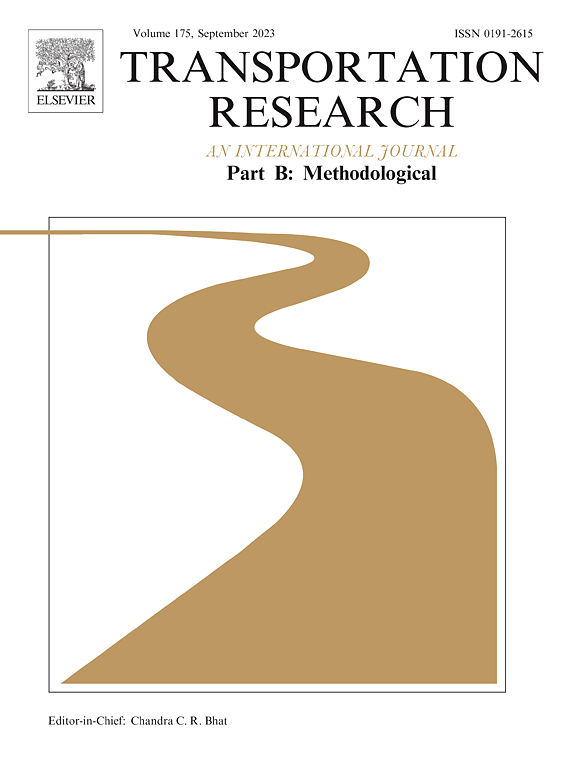A modeling methodology for car-following behaviors of automated vehicles: Trade-off between stability and mobility
IF 6.3
1区 工程技术
Q1 ECONOMICS
引用次数: 0
Abstract
Empirical studies have indicated that automated vehicle (AV) automakers tend to prioritize mobility over stability in designing car-following (CF) models, which may raise safety concerns. A likely explanation for this issue is that hardware-induced response delays challenge the ability of the CF models, as designed by automakers, to maintain an equilibrium between stability and mobility. To address these concerns, this study proposes a modeling methodology for the CF model in AVs aimed at achieving a trade-off between stability and mobility. This methodology seeks to identify the optimal parameters that enhance mobility under stability constraints. First, the linear CF model is calibrated using data from 20 commercial AVs produced by multiple automakers, and the unique response delay values of the linear CF model for each AV are identified. Next, the parameter regions ensuring stability are derived theoretically based on the calibrated response delays for each AV. An optimal mobility objective function is constructed to minimize time headway and reaction time, with the boundaries of the stable parameter regions serving as constraints. It allows the selection of CF parameters that maximize mobility while remaining within the stable regions. This proposed modeling method is applied to all AVs, and the optimal parameters are tested in simulations. Simulation results demonstrate that the proposed optimal model effectively dampens oscillations, reduces safety risks, and maintains shorter spacing, thus achieving an ideal trade-off between stability and mobility for AVs.
自动驾驶车辆跟车行为的建模方法:稳定性与机动性的权衡
实证研究表明,自动驾驶汽车(AV)制造商在设计汽车跟随(CF)模型时倾向于优先考虑移动性而不是稳定性,这可能会引发安全问题。对于这个问题,一个可能的解释是,硬件引起的响应延迟挑战了汽车制造商设计的CF模型在稳定性和移动性之间保持平衡的能力。为了解决这些问题,本研究提出了一种自动驾驶汽车CF模型的建模方法,旨在实现稳定性和移动性之间的权衡。该方法旨在确定在稳定性约束下增强机动性的最佳参数。首先,使用多家汽车制造商生产的20辆商用自动驾驶汽车的数据对线性CF模型进行校准,并确定每辆自动驾驶汽车的线性CF模型的唯一响应延迟值。其次,基于标定后的响应延迟,从理论上推导出保证稳定的参数区域,并以稳定参数区域的边界作为约束条件,构造出保证车头时距和反应时最小的最优机动性目标函数。它允许CF参数的选择,最大限度地提高流动性,同时保持在稳定区域内。将所提出的建模方法应用于所有自动驾驶汽车,并对最优参数进行了仿真验证。仿真结果表明,该优化模型有效地抑制了自动驾驶汽车的振荡,降低了安全风险,并保持了较短的间距,从而实现了自动驾驶汽车稳定性和移动性之间的理想平衡。
本文章由计算机程序翻译,如有差异,请以英文原文为准。
求助全文
约1分钟内获得全文
求助全文
来源期刊
CiteScore
12.40
自引率
8.80%
发文量
143
审稿时长
14.1 weeks
期刊介绍:
Transportation Research: Part B publishes papers on all methodological aspects of the subject, particularly those that require mathematical analysis. The general theme of the journal is the development and solution of problems that are adequately motivated to deal with important aspects of the design and/or analysis of transportation systems. Areas covered include: traffic flow; design and analysis of transportation networks; control and scheduling; optimization; queuing theory; logistics; supply chains; development and application of statistical, econometric and mathematical models to address transportation problems; cost models; pricing and/or investment; traveler or shipper behavior; cost-benefit methodologies.

 求助内容:
求助内容: 应助结果提醒方式:
应助结果提醒方式:


